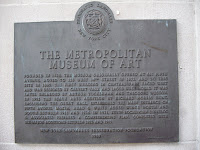
The Wadsworth Atheneum Museum in Hartford

Inside the Lobby of the Wadsworth Atheneum Museum

Fountain located inside the museum

Francesco Maria Francia
Italian (Bolognese), c. 1450-1517
"Madonna and Child with Saint Francis," c. 1505
Oil on panel
Gift of Mrs. T.W. Inglis-Jones 1960.259

Taddeo di Bartolo
Sienese, 1362-1422
"Madonna and Child"
Tempera and oil on panel
Gift of the Robert Lehman Art Foundation, 1962.444

Jack Whitten
Born in Bessemer, Alabama, 1939
"Einstein's Violin," 1991
Acrylic on canvas
The Ella Gallup Sumner and Mary Catlin Sumner Collection Fund, 1992.25

Norman Lewis
Born Bermuda 1909
Died New York City 1979
"Green Mist," 1949
Oil on canvas
Ella Gallup Sumner and Mary Catlin Sumner Collection Fund, 1995.35.1

Richard Barthe'
Born in Bay St. Louis, Mississippi, 1901
Died in Pasadena, california, 1989
"The Negro Looks Ahead, c. 1944
Bronze
Gift of the Vernon K. Krieble Foundation, 1989.4

Gustave Courbet
French, 1819-1877
"The Shore at Trouville: Sunset Effect," 1866
Oil on canvas
Gift in honor of Helene and Max Eisner, by exchange, with additional funds provided by the Ella Gallup Sumner and Mary Catlin Sumner Fund, 2006.15.1

John Federick Kensett
American, 1816-1872
"Coast Scene with Figures (Beverly Shore)", 1869
Oil on canvas
The Ella Gallup Sumner and Mary Catlin Sumner Collection Fund, 1942.345

Vincent van Gogh
Dutch, 1853-1890
"Self Portrait," c. 1887
Oil on canvas
Gift of Phillip L. Goodwin in memory of his Mother,Josephine S. Goodwin, 1954.189
My featured artist for the Atheneum Museum is Vincent van Gogh. This portrait is one of 35 self portraits that he painted. The technique used to create this portrait was called broken color. This technique enhanced the lighting in portraits and was frequently used by impressionist. Van Gogh was known to paint quickly. He used the paint straight from the tube and painted in thick brush strokes. Painting in this manner is called impasto. This is well noted in this asymmetrical portrait which was painted in 1887. Van Gogh’s self image dominates the painting. The message conveyed is one of despair. Van Gogh’s use of dark, muted shades in the background forced me to focus on his pale, white face, which further emphasizes his blue eyes. The hopeless, melancholy look in his eyes and the pale face all sitting in the middle of the darkness surrounding the subject gave me the feeling that he was a depressed man when he posed for this portrait. He used various shades of yellows, oranges, reds, browns, and even some blues on his hair and beard, which looked unkempt. His shirt is a combination of white, blues, and reds.
For van Gogh, he used art as a way of expressing his thoughts and emotions. His self portraits were purely autobiographical. His paintings usually expressed his moods. During happier times the colors in his paintings were brighter. When he was depressed, his paintings were darker such as in the painting titled “Whistler’s Mother.”
Vincent van Gogh was born in 1853 in Groot-Zundert, Holland. He was a very nervous man who often stayed up all night and painted all day. This lifestyle helped in the decline of his health. At one point, van Gogh ended up in an asylum in Saint-Remy for treatment of mental illness. Van Gogh only sold one painting during his entire lifetime. He lived very poorly and was supported by his brother and close friends. In July of 1890, van Gogh committed suicide by shooting himself. In addition to being a great impressionist painter, he is also known for cutting off part of his left ear.
Works Cited
http://www.vangoghgallery.com/misc/bio.html
















































